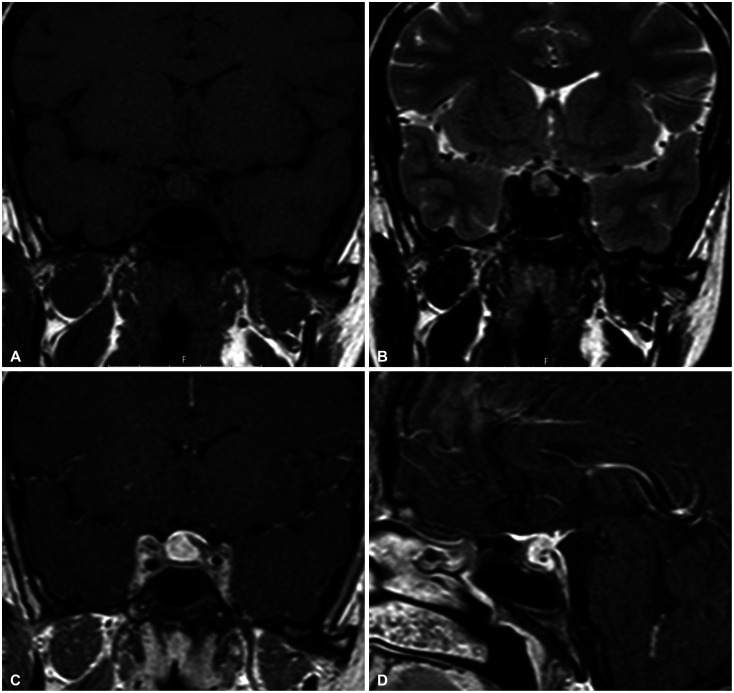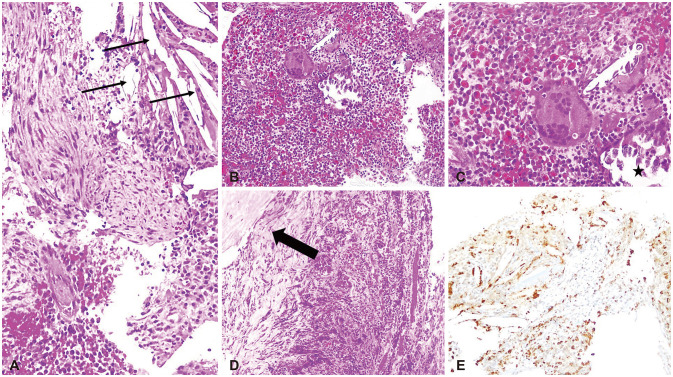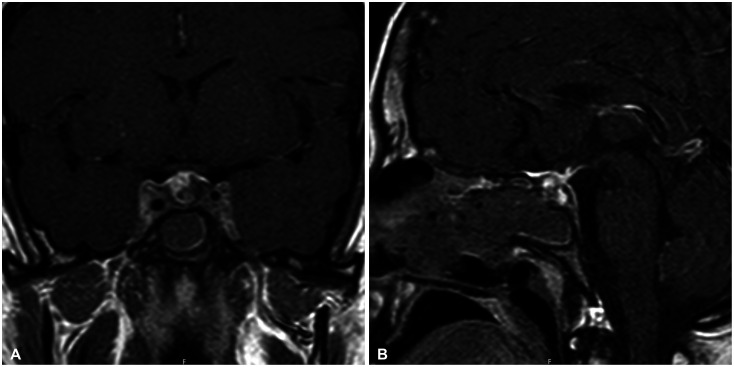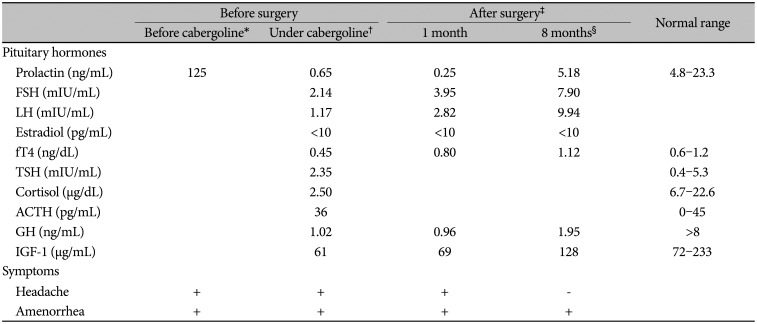1. Angelousi A, Alexandraki K, Tsoli M, Kaltsas G, Kassi E. Hypophysitis (including IgG4 and immunotherapy). Neuroendocrinology. 2020; 110:822–835. PMID:
32126548.

2. Caranci F, Leone G, Ponsiglione A, Muto M, Tortora F, Muto M, et al. Imaging findings in hypophysitis: a review. Radiol Med. 2020; 125:319–328. PMID:
31863360.

3. Faje A. Hypophysitis: evaluation and management. Clin Diabetes Endocrinol. 2016; 2:15. PMID:
28702249.

4. Gubbi S, Hannah-Shmouni F, Verbalis JG, Koch CA. Hypophysitis: an update on the novel forms, diagnosis and management of disorders of pituitary inflammation. Best Pract Res Clin Endocrinol Metab. 2019; 33:101371. PMID:
31866206.
5. Mathkour M, Zeoli T, Werner C, Scullen T, Garces J, Keen J, et al. Recurring primary xanthomatous hypophysitis behaving like pituitary adenoma: additional case and literature review. World Neurosurg. 2020; 138:27–34. PMID:
32081821.
6. Hanna B, Li YM, Beutler T, Goyal P, Hall WA. Xanthomatous hypophysitis. J Clin Neurosci. 2015; 22:1091–1097. PMID:
25957783.

7. Oishi M, Hayashi Y, Fukui I, Kita D, Miyamori T, Nakada M. Xanthomatous hypophysitis associated with autoimmune disease in an elderly patient: a rare case report. Surg Neurol Int. 2016; 7:S449–S453. PMID:
27500004.

8. Aste L, Bellinzona M, Meleddu V, Farci G, Manieli C, Godano U. Xanthomatous hypophysitis mimicking a pituitary adenoma: case report and review of the literature. J Oncol. 2010; 2010:195323. PMID:
20671950.

9. Joung JY, Jeong H, Cho YY, Huh K, Suh YL, Kim KW, et al. Steroid responsive xanthomatous hypophysitis associated with autoimmune thyroiditis: a case report. Endocrinol Metab (Seoul). 2013; 28:65–69. PMID:
24396654.

10. Singh K, Kanodia AK, Ross P, Torgersen A, Maclean J, Leese G, et al. Xanthomatous hypophysitis causing hypogonadotropic hypogonadism resulting in delayed presentation of slipped capital femoral epiphysis. Br J Neurosurg. 2018; 11. 19. [Epub]. Available at: . DOI:
10.1080/02688697.2018.1525482.

11. Duan K, Asa SL, Winer D, Gelareh Z, Gentili F, Mete O. Xanthomatous hypophysitis is associated with ruptured Rathke’s cleft cyst. Endocr Pathol. 2017; 28:83–90. PMID:
28120170.
12. Kleinschmidt-DeMasters BK, Lillehei KO, Hankinson TC. Review of xanthomatous lesions of the sella. Brain Pathol. 2017; 27:377–395. PMID:
28236350.
13. Folkerth RD, Price DL Jr, Schwartz M, Black PM, De Girolami U. Xanthomatous hypophysitis. Am J Surg Pathol. 1998; 22:736–741. PMID:
9630181.

14. Niyazoglu M, Celik O, Bakkaloglu DV, Oz B, Tanriöver N, Gazioglu N, et al. Xanthomatous hypophysitis. J Clin Neurosci. 2012; 19:1742–1744. PMID:
22682648.
15. Gutenberg A, Hans V, Puchner MJ, Kreutzer J, Brück W, Caturegli P, et al. Primary hypophysitis: clinical-pathological correlations. Eur J Endocrinol. 2006; 155:101–107. PMID:
16793955.
16. Burt MG, Morey AL, Turner JJ, Pell M, Sheehy JP, Ho KK. Xanthomatous pituitary lesions: a report of two cases and review of the literature. Pituitary. 2003; 6:161–168. PMID:
14971740.
17. Komatsu F, Tsugu H, Komatsu M, Sakamoto S, Oshiro S, Fukushima T, et al. Clinicopathological characteristics in patients presenting with acute onset of symptoms caused by Rathke’s cleft cysts. Acta Neurochir (Wien). 2010; 152:1673–1678. PMID:
20495985.
18. Sonnet E, Roudaut N, Mériot P, Besson G, Kerlan V. Hypophysitis associated with a ruptured Rathke’s cleft cyst in a woman, during pregnancy. J Endocrinol Invest. 2006; 29:353–357. PMID:
16699303.
19. Miyajima Y, Oka H, Utsuki S, Fujii K. Rathke’s cleft cyst with xanthogranulomatous change--case report. Neurol Med Chir (Tokyo). 2011; 51:740–742. PMID:
22027255.
20. Amano K, Kubo O, Komori T, Tanaka M, Kawamata T, Hori T, et al. Clinicopathological features of sellar region xanthogranuloma: correlation with Rathke’s cleft cyst. Brain Tumor Pathol. 2013; 30:233–241. PMID:
23322180.
21. Schittenhelm J, Beschorner R, Psaras T, Capper D, Nägele T, Meyermann R, et al. Rathke’s cleft cyst rupture as potential initial event of a secondary perifocal lymphocytic hypophysitis: proposal of an unusual pathogenetic event and review of the literature. Neurosurg Rev. 2008; 31:157–163. PMID:
18253771.
22. Cheung CC, Ezzat S, Smyth HS, Asa SL. The spectrum and significance of primary hypophysitis. J Clin Endocrinol Metab. 2001; 86:1048–1053. PMID:
11238484.
23. Hama S, Arita K, Nishisaka T, Fukuhara T, Tominaga A, Sugiyama K, et al. Changes in the epithelium of Rathke cleft cyst associated with inflammation. J Neurosurg. 2002; 96:209–216. PMID:
11838792.
24. Nishikawa T, Takahashi JA, Shimatsu A, Hashimoto N. Hypophysitis caused by Rathke’s cleft cyst. Case report. Neurol Med Chir (Tokyo). 2007; 47:136–139. PMID:
17384498.
25. Wong JSL, Nasruddin AB, Selveindran NM, Latif KA, Kassim F, Nair SB, et al. Xanthomatous hypophysitis presenting in an adolescent girl: a long-term follow-up of a rare case and review of the literature. AACE Clin Case Rep. 2021; 7:220–225. PMID:
34095493.
26. Lin W, Gao L, Guo X, Wang W, Xing B. Xanthomatous hypophysitis presenting with diabetes insipidus completely cured through transsphenoidal surgery: case report and literature review. World Neurosurg. 2017; 104:1051.e7–1051.e13.









 PDF
PDF Citation
Citation Print
Print



 XML Download
XML Download